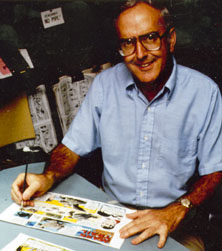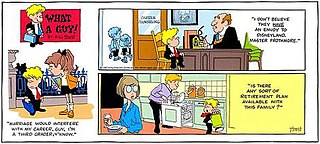Service life
Gurney visited army camps throughout Australia and New Guinea to ensure authenticity. [11] While in New Guinea he contracted malaria and was incapacitated for some time. [12]

| Bluey and Curley | |
|---|---|
| First appearance | 1939 |
| Created by | Alex Gurney |
Bluey and Curley is an Australian newspaper comic strip written by the Australian artist, caricaturist, and cartoonist Alex Gurney. [1]
Few original Bluey and Curley strips are held in public collections, because Gurney often gave the original art work of his caricatures, cartoons, and comic strips to anyone who asked. [2] Following Gurney's death in 1955, the strip was taken over by Norm Rice in early 1956, but he died in a vehicle accident that year. Bluey and Curley was then taken over by cartoonist Les Dixon who drew it for 18 years until he retired in 1975.
The first Bluey and Curley strip appeared soon after the start of World War II. It featured two Australian soldiers, Bluey (who had served in the First AIF), and Curley, a new recruit.
By the end of the war, they had served in every Australian campaign — in North Africa, in the Middle East, in New Guinea, in Northern Australia, and in the Pacific Islands — and, once the war was over, they even went to London and took part in the 1946 Victory Parade.
Bluey and Curley epitomised what was seen as the typical Australian soldier. They liked a drink, a gamble and a chat (in colourful Aussie slang of course), and they always had some scheme afoot. They had a healthy disregard for officers and regulations and were quick to bring down any mates who were getting too big for their boots. Despite their larrikin streak, they were fearless, resilient and skilled in battle.
Alex Gurney, the creator of Bluey & Curley, produced the strip from 1940 until his death in 1955. It was syndicated across Australia and appeared in New Zealand, New Guinea, and Canada (but was considered too Australian for American newspapers). [3]
By 1939, Alex Gurney was already well established as a caricaturist, cartoonist, and comic strip artist.
In late 1939, following the outbreak of World War II, he created his most famous characters, Bluey and Curley, [4] which first appeared in the Picture-News magazine.
He applied for the copyright registration of Bluey and Curley on 16 October 1939; and his application was granted on 9 November 1939 (Australian Copyright No.6921). [5]
It was transferred to The Sun News-Pictorial in 1940, from whence it was syndicated throughout Australia, [6] New Zealand and Canada. [7]
The strip featured a pair of soldiers, "Bluey" (named for his red hair), [8] the Great War veteran who had re-enlisted in the second A.I.F., and Curley (named for his extremely curly hair), the new recruit to the A.I.F. [9]
The strip was widely appreciated for the good-humoured way it depicted the Australian "diggers" and their "mateship", as well as for its realistic use of Australian idiom of the day. [10]
Gurney visited army camps throughout Australia and New Guinea to ensure authenticity. [11] While in New Guinea he contracted malaria and was incapacitated for some time. [12]

Gurney was in England in June 1946, as part of an Australian Press Syndicate sent specifically to view the Victory Parade. As well as sending caricatures of various eminent people involved in that parade back to Australia for distribution through the press, he also used the opportunity to have Bluey and Curley attend the parade, and a number of his Bluey and Curley comic strips reflected that event. [14]
Gurney's visit to London, and his version of events, as seen through his Bluey and Curley comic strip, was also historically significant for another reason: it was the first time that a newspaper comic strip had ever been transmitted from England to Australia by radio. [15]
Although Bluey and Curley were popular with Australians because they related to the slang, attitude, and the lack of respect towards authority exhibited by the main characters, [16] the strip lost some of its appeal and readership when the pair returned to "civvy street". [17]
Gurney died suddenly, of heart disease, on 4 December 1955. He had collapsed in his car parked outside his home. [18]
The strip was later drawn by Norman Howard Rice (1911–1956). Rice died as the result of a car accident on 31 December 1956 (New Year's Eve). [19] The strip was then drawn by Les Dixon from 1957 until 1975.
The comic was adapted into a TV film Mud, Bloody Mud in 1985.

A comic strip is a sequence of drawings, often cartoons, arranged in interrelated panels to display brief humor or form a narrative, often serialized, with text in balloons and captions. Traditionally, throughout the 20th and into the 21st century, these have been published in newspapers and magazines, with daily horizontal strips printed in black-and-white in newspapers, while Sunday papers offered longer sequences in special color comics sections. With the advent of the internet, online comic strips began to appear as webcomics.

A cartoonist is a visual artist who specializes in both drawing and writing cartoons or comics. Cartoonists differ from comic writers, comic book artists, or comic book illustrators in that they produce both the literary and graphic components of the work as part of their practice. Cartoonists may work in a variety of formats, including booklets, comic strips, comic books, editorial cartoons, graphic novels, manuals, gag cartoons, storyboards, posters, shirts, books, advertisements, greeting cards, magazines, newspapers, webcomic, and video game packaging.

Alexander Gillespie Raymond Jr. was an American cartoonist who was best known for creating the Flash Gordon comic strip for King Features Syndicate in 1934. The strip was subsequently adapted into many other media, from three Universal movie serials to a 1950s television series and a 1980 feature film.
The Australian Cartoonists' Association is the Australian professional cartoonists' organisation and was established on 17 July 1924 as the Society of Australian Black and White Artists.
United Feature Syndicate is a large American editorial column and comic strip newspaper syndication service based in the United States and established in 1919. Originally part of E. W. Scripps Company, it was part of United Media from 1978 to 2011, and is now a division of Andrews McMeel Syndication. United Features has syndicated many notable comic strips, including Peanuts, Garfield, Li'l Abner, Dilbert, Nancy, and Marmaduke.
Ace Comics was a comic book series published by David McKay Publications between 1937 and 1949 — starting just before the Golden Age of Comic Books. The title reprinted syndicated newspaper strips owned by King Features Syndicate, following the successful formula of a mix of adventure and humor strips introduced by McKay in their King Comics title in April 1936; some of the strips were transferred from King Comics and continued in Ace Comics from issue #1. Ace Comics #11, the first appearance of The Phantom, is regarded by many to be a key issue in the history of comics, as it introduced to the comics format one of the first of the costumed heroes, leading to the Golden Age of superheroes in comics.

Morris S. Weiss was an American comic book and comic strip artist and writer. Active from the 1930s through the mid-1970s, he created the teen-comedy character "Margie" for Timely Comics, the 1940s predecessor of Marvel Comics, and was the final cartoonist on the comic strip Mickey Finn. He also worked as a writer or illustrator on numerous other strips, including Joe Palooka.

Martin Michael Branner, known to his friends as Mike Branner, was a cartoonist who created the popular comic strip Winnie Winkle.
Snake Tales is a gag-a-day comic strip written by Australian cartoonist Allan Salisbury.
The Eastern Color Printing Company was a company that published comic books, beginning in 1933. At first it was only newspaper comic strip reprints, but later on original material was published. Eastern Color Printing was incorporated in 1928, and soon became successful by printing color newspaper sections for several New England and New York papers. Eastern is most notable for its production of Funnies on Parade and Famous Funnies, two publications that gave birth to the American comic book industry.
A comic strip syndicate functions as an agent for cartoonists and comic strip creators, placing the cartoons and strips in as many newspapers as possible on behalf of the artist. A syndicate can annually receive thousands of submissions, from which only two or three might be selected for representation. In some cases, the work will be owned by the syndicate as opposed to the creator. The Guinness World Record for the world's most syndicated strip belongs to Jim Davis' Garfield, which at that point (2002) appeared in 2,570 newspapers, with 263 million readers worldwide.
Bluey may refer to:

What a Guy! is an American comic strip created by Bill Hoest and Bunny Hoest, the team responsible for The Lockhorns and Agatha Crumm. It began in March 1987, just over a year before Hoest's death in 1988.

Alexander George Gurney was an Australian artist, caricaturist, and cartoonist born at Pasley House, Stoke, Devonport, England.
Curley is a surname, given name, nickname or stage name. It may refer to:
Leslie Dixon (1910–2002), was an Australian cartoonist and commercial artist.
Norman Howard Rice was an Australian cartoonist, comic book artist and illustrator.
Mud, Bloody Mud is a 1985 Australian television film based on a popular comic strip, Bluey and Curley. These comic book characters link documentary footage with puppets playing political figures.
Margaret Jane Gurney is an Australian artist who lives and works in Melbourne and is an advocate for Australian arts.